When the winter ends and warmer spring temperatures arrive, amphibians emerge from hibernation and migrate to breeding sites to lay their eggs.
Most amphibians will lay their eggs in the water, but many will lay their eggs on land. Amphibian eggs laid in the water can be difficult to tell apart unless you have a close eye to watch for differences.
The easiest way to tell the difference between frog eggs and salamander eggs is to look at the outer layer of the egg mass. Frog egg masses have an outer layer that is made up of the eggs themselves, while salamander egg masses have an outer layer of jelly surrounding the entire egg mass.
If you took a close look at a frog egg mass, you would easily notice the contour of each egg on the outer layer of the egg mass.
With a salamander egg mass, you would not see any contour since the individual eggs would be lodged deep inside the outer jelly coat
Where Do Amphibians Lay Their Eggs?
In early spring, amphibians will emerge from hibernation and migrate to breeding sites. They typically make this migration on the first few rainy nights of spring, when the temperatures are hovering around 40-50°F.
This mass amphibian migration is nicknamed “the big night”. People will travel to see this event, and very often stop traffic to allow hundreds of salamanders and frogs to cross roads on their way to the breeding ponds.
During this migration, amphibians can travel significant distances, sometimes of up to half a mile, to reach deep enough water where they will breed and lay their eggs.
This could be in ponds, lake edges, slow-moving streams, roadside ditches, or even deep tire tracks, but most amphibians very strongly prefer to breed in something called “vernal pools“.

Vernal pools are temporal pools of water that form in the spring. They are formed when depressions on the ground are filled with water from melting snow and falling rain.
Vernal pools are typically small and shallow, and unlike a pond or lake, they have no permanent source of water. This means they dry up in the summer.
Since they are temporal, they do not have fish that could eat aquatic eggs before they hatch, which makes them ideal amphibian breeding sites.
Once in the water, amphibians will mate, and the females will fertilize their eggs. After a few days, the females will lay eggs and attach them to submerged vegetation or on the underside of submerged rocks near the water surface.
The Differences Between Salamander Eggs and Frog Eggs
As mentioned earlier, the easiest way to tell the difference between salamander eggs from frog eggs is to look at the outer layer of the egg mass.
Frog egg masses have an outer layer that is made up of the eggs themselves, while salamander eggs masses have a protective outer jelly coat around the entire mass.
If you took a close look at a frog egg mass, you would easily notice the contour of each individual egg outside of the egg mass.


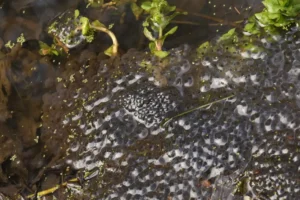

On the other hand, if you took a close look at a salamander egg mass, you would not see any contour since the entire mass is covered by an outer jelly coat. However, if you very closely looked into the jelly, you would notice the outline of each individual egg within the mass.

Here is another salamander egg mass where you can see a very prominent layer of jelly surrounding the entire mass.


Also, salamander eggs tend to hold together better than frog eggs.
If you were to pick up a salamander egg mass, it would hold together due to the outer jelly coat around the egg mass.

However, if you were to pick a frog egg mass, it would be looser and break apart very easily.
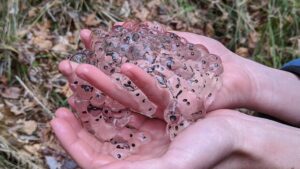
twig suspended above the water.
If you picked up a salamander egg mass, the outer layer of jelly would hold the entire egg mass very firmly together. However, if you picked up a frog egg mass, the eggs would fall apart more easily due to the lack of outer jelly to support the egg mass.
Here is what the eggs of a Jefferson salamander look like next to those of a wood frog.

Here Is What Frog Eggs vs Salamander Eggs Look Like When Submerged in a Pond:

Frog eggs will look bubbly and bumpy while floating on the surface of the water, while salamander eggs will look like a blob of jelly with eggs visible inside.
Identifying Frog Eggs
Frogs lay individual eggs all clumped together that float on the surface of the water. The eggs are usually clear, with a visible embryo contained within each egg, but sometimes they may be slightly different colors.
They may be cream-colored, have a tint of brown, yellow, or even have a green glow from algae.
A good way to tell frog and salamander eggs apart is to learn how to identify the eggs of individual frog and salamander species.
Here’s how you can identify the eggs of 6 frog species:
1. Wood Frog (Lithobates sylvaticus)
Wood frog lay their eggs in clusters, attached to twigs or vegetation, just below the surface of the water.
If the pool has lots of emergent vegetation, eggs are often laid in open areas that receive lots of sunlight.
Freshly laid wood frog egg masses are dense and are roughly the size of a golf ball.

Over time, the eggs absorb water and swell to their true size, which is usually roughly the size of a softball.
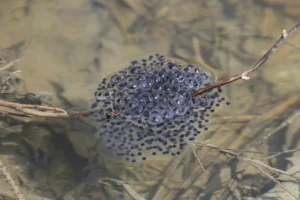
Each Wood frog egg mass can have anywhere from 500, to as many as 2,000 eggs.
A single Wood frog can lay 1,000, to 3,000 eggs in a breeding season.
The embryos in the eggs are black on top and white on the bottom, but as the embryos develop into tadpoles, the white is lost.
Wood frogs often lay their egg masses communally, so it’s common to find large rafts of wood frog egg masses, containing many layers of masses on top of one another.

Over a short time, wood frog egg masses may become colonized by symbiotic algae, giving them a greenish coloration.

The eggs hatch in 9 to 30 days, depending on the ambient temperatures.
2. Northern Leopard Frog (Lithobates pipiens)
Like wood frogs, Leopard frogs lay their eggs masses are laid in areas of the pool that receive lots of sunlight.
Leopard frog egg masses are typically firm and globular and are about the same size as those of the Wood frog.

The only difference is that they are much denser (more tightly packed) and contain more eggs – usually 2,000-3,000 eggs per egg mass, but a single egg mass can have up to 6,500 eggs.

In addition, the layer of clear jelly that surrounds the yolk is much thinner than in wood frog eggs.
Since the egg masses are more tightly packed, the layer of clear jelly that surrounds each embryo is much thinner than in Wood frog eggs.

This results in individual Leopard frog eggs being much smaller than those of the Wood frog.
Since Leopard frog eggs have a very thin layer of jelly, they do not appear as clear as Wood frog eggs. Rather, they are black on top and white on the bottom.

Northern leopard frog eggs take about 7 to 17 days to hatch, depending on the ambient temperatures.
The eggs of Pickerel frogs (Lithobates palustris) are almost identical to those of Leopard frogs. The main difference is that rather than being black on top and white on the bottom, Pickerel frog eggs are brown on the top and a cream-ish yellow on the bottom.
3. Gray Tree Frog (Dryophytes versicolor)
Gray tree frogs lay their eggs in small packets of 10 – 40 eggs on the surface of the water.

A single Gray tree frog can lay 1,000 to as many as 2,000 eggs in a breeding season.
Oftentimes, the egg masses are generally really close to, or loosely attached to debris, branches, or emergent vegetation
Each egg is dark brown on the top and a yellowish cream color on the bottom, and is surrounded by a protective gelatinous mass.

As the embryos develop, Gray tree egg masses will deteriorate and flatten to the point where individual eggs are no longer identifiable from the rest of the floating raft.

Gray tree frog eggs take about 3 to 7 days to hatch, depending on the ambient temperatures.
4. American Bullfrog (Lithobates catesbeianus)
Unlike most frogs, American bullfrogs do not lay eggs in tight masses. Rather, their eggs are laid in a loose mass draped on underwater plants, slightly below the water’s surface.
After about a day, the egg cluster floats to the water surface and flattens out into a giant thin sheet, only about one or two eggs thick.



Each egg mass can have anywhere from 12,000, to as many as 20,000 eggs.
The eggs take about 3 to 5 days to hatch, depending on the ambient temperatures.
The eggs of the Green frog (Lithobates clamitans) are nearly identical to those of the American bullfrog. The main difference is that American bullfrog egg masses are much larger (over 3ft in diameter) and have 12, 000 to 20, 000 eggs each, while Green frog egg masses are smaller and only have 1,000 to 7,000 eggs.
5. Spring Peeper (Pseudacris crucifer)
Unlike many frogs which lay their eggs in masses, Spring peepers lay their eggs singly or in clumps of two or three.

The eggs are attached to submerged vegetation or debris, just below the surface of the water.
A single Spring peeper can lay anywhere from 900 to 1,000 eggs each breeding season.
Spring peeper eggs are very small and can be hard to see when laid singly.

Each egg has a yellowish-cream color and is surrounded by a protective gelatinous mass.

The eggs take about 4 to 15 days to hatch, depending on the ambient temperatures.
6. European Common Frog (Rana temporaria)
European common frogs lay their eggs in clusters, attached to twigs or vegetation, just below the surface of the water.
Each egg mass can have 500, to as many as 2,000 eggs.
Individual eggs are black and have black embryos (that appear as black dots at the center), surrounded by a clear jelly capsule about 1 cm across.



The eggs take about 14 to 28 days to hatch, depending on the ambient temperatures.
Deposit ‘rafts’ of spawn, often containing up to 2000 eggs. Each small black egg is surrounded by a clear jelly capsule around 1 cm across.
Identifying Salamander Eggs
Most salamanders lay eggs in the water. These eggs look somewhat like frog eggs; they are laid in masses and attached to submerged plants near the water surface. However, unlike frog eggs, salamanders eggs have a thick layer of jelly covering the whole mass of eggs.
The jelly is usually clear or cloudy white but can be brown, cream-colored, or even have a bright green glow from algae (depending on the species).
This jelly protects the eggs from drying out if the water level in the pool drops. It also protects them from predators such as frogs or newts.
Here is how you can identify salamander eggs
Spotted Salamander Eggs
Spotted salamanders lay eggs attached to sticks and other vegetation, slightly below the water surface.
Like wood frogs, spotted salamanders often lay their eggs in communal breeding spots, so it’s common to find multiple spotted salamander egg masses in the same spot or attached to the same plants.

Each egg mass is roughly the size of a grapefruit and may contain anywhere from 50 to 250 eggs. Individual egg masses are covered in an outer layer of jelly, that holds its shape even out of water.
The jelly is usually clear, but can be opaque white, or have a greenish color from algae.

These eggs will hatch in 40-60 days.
Jefferson Salamander Eggs
Like spotted salamanders, Jefferson salamanders lay their eggs in jelly-covered masses attached to sticks and other vegetation slightly below the water surface.
However unlike spotted salamanders, Jefferson salamander egg masses usually only have 20-30 eggs, but can have up to 60 eggs. Females will lay multiple masses, often laid down in a line on the same stick. As they swell with water, they may fuse into one another and look like one large mass.

Jefferson salamander egg masses are clear and have a loose consistency. If you pick up a Jefferson mass, the eggs will run through your fingers rather than hold their shape.

Northwestern Salamander Eggs
Unlike Jefferson salamander eggs, Northwestern salamander eggs are very firm. Each egg mass has roughly 50-100 eggs ( the egg mass is about the size of a small orange) and is attached to vegetation 1.5 to 6 feet below the water surface.

When first laid, the jelly surrounding the egg mass is crystal clear. However, with time, the egg mass may get a greenish color from algae growing inside of the jelly.
These algae provide oxygen to the developing embryo in return for nitrogenous wastes that fertilize the algae

The individual eggs are brownish and the jelly around the egg mass is very firm and dense.
Tiger Salamander Eggs
Tiger salamanders lay their eggs in the deeper parts of the pond that are less susceptible to the elements but still receive lots of sunlight. This is often among twigs and leaves on the very bottom of a pond.
Eastern tiger salamanders lay their eggs in masses, but some tiger salamander subspecies lay their eggs singly, often in a line on the same stick.

Tiger salamander egg masses can have can anywhere from 40 to 100 eggs. The jelly surrounding the egg mass is clear or a cloudy white and is very fragile. If you picked up a tiger salamander egg mass, the jelly would not hold its shape.

The eggs are brownish cream color and will hatch after 19-50 days.
Long-Toed Salamander Eggs
Long-toed salamanders lay their eggs in small masses of 2 to 25 eggs, but sometimes the eggs are laid singly. Females will lay multiple masses, laying up to 250 eggs in a single breeding season.
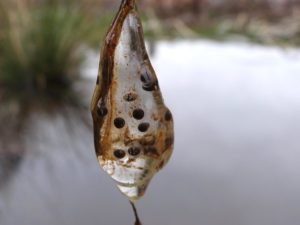
The individual eggs (minus the outer layer of jelly) have a double protective layer and are widely spaced by lots of jelly. As the embryos develop, this double layer breaks down and becomes less visible.

The outer jelly coating has a loose consistency and will jiggle if you move the nearby water.

Toad eggs and Newt eggs
Although usually laid in the same breeding sites, toad and newt eggs are somewhat different from frog and salamander eggs.
Identifying Toad eggs
Toad egg masses are laid in long strings (one to three eggs wide) along plants or on the bottoms of shallow water in ponds. The eggs are covered in jelly and look almost like a jelly-coated necklace.
Sometimes sediment settles on toad egg masses, covering individual eggs making them look like giant worms!
Here is how you can identify the eggs of a few toads.
American Toad Eggs
American toads lay 4000 to 12000 eggs in two long parallel strands attached to aquatic vegetation or resting on the pond bottom.
When each row of eggs is stretched, it generally measures between 20 to 66 ft (6 to 20 meters).


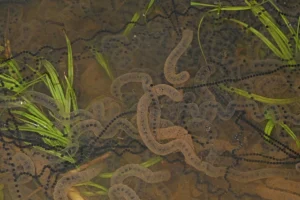
The egg strands have a coiled pattern, but appear linear when examined close up. Each egg is 1.5 mm in diameter and will hatch anywhere from 2 to 14 days.
Fowler’s Toad Eggs
Fowler’s toad eggs look very nearly identical to those of the American toad.

The main distinction between the two is;
- The eggs of the American toad have a double envelope surrounding the eggs, with the individual eggs separated by partitions
- The eggs of the Fowler’s toad have a single membrane, and the individual eggs are not separated by partitions.
Apart from this distinction, the eggs of these two toad species are virtually identical
Western Toad Eggs
Western toads egg strands are usually two eggs wide but are sometimes three eggs wide. Egg strands can be up to 60ft long and contain as many as 7000 eggs, with the eggs spaced roughly 13 to 52 eggs per inch.
A single female can lay over 18000 eggs in a single breeding season.
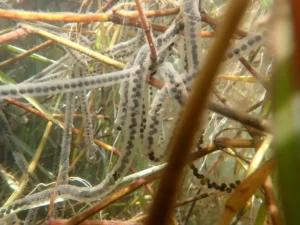


The individual eggs are black on top, and white at the bottom and are surrounded by two layers of jelly.
The eggs are pretty small, only measuring about 1.5 to 1.8 mm in diameter (minus the jelly), and will hatch in 3 to 10 days.
Identifying Newt Eggs
Unlike “true salamanders” or frogs, most newts do not lay their eggs in masses. Rather, female newts lay eggs singly and wrap each egg with the leaf of a pond plant using their back legs.
They do this to protect the eggs from predators, such as frogs, or even other newts.
However, some newts such as the California newt lay eggs in small masses rather than singly. The egg masses are covered in an outer layer of jelly, kind of similar to how most “true salamanders” lay their eggs.
Here is how you can identify the eggs of a few newts.
California Newt Eggs
As mentioned earlier, California newts do not lay eggs singly. Rather, they lay their eggs in small spherical masses ( 7 to 30 eggs) attached to submerged vegetation or under submerged rocks.
Each egg mass is surrounded by a poisonous layer of jelly to protect the eggs from predators. The jelly is clear and has the consistency of thick gelatin.

It will be 14 days or as long as 52 days before the eggs hatch.
Eastern Newt Eggs
Eastern newts lay between 200 and 400 single jelly-covered eggs attached to submerged vegetation. The female will often wrap each egg in the leaf of a pond plant or other underwater debris using their back legs
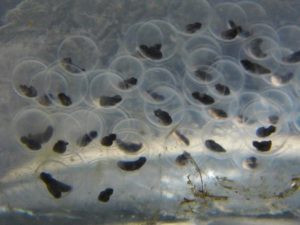
A single newt will lay a few eggs each day in different places, so it is common to find eggs spread across a wide area. The eggs will hatch in about 5 weeks.
Things Mistaken for Amphibian Eggs
if you saw a jelly-like mass attached to submerged tree branches and other vegetation, you would probably think its an amphibian egg mass. But this is not always the case. Sometimes, it could just be a bryozoa colony.
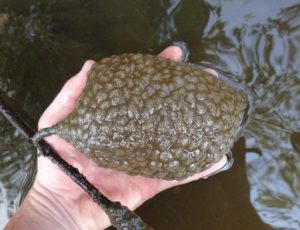
Bryozoans are microscopic aquatic animals similar, but not related, to corals. Their name literally means “moss animal”.
Bryozoans are fairly common in lakes, streams, and other water bodies, and form jelly-like colonies attached to rocks or submerged branches.

The colonies are firm and have weird crusty-looking things on the outside, but never have embryos on the inside. Many people confuse bryozoa colonies for amphibian eggs, but now you know better.

Final Thoughts
If you are interested in observing amphibian eggs, act quickly in the spring. The eggs usually only remain for a few weeks and the embryos develop rapidly.
Some species develop and hatch in under a week so it’s worth visiting a site frequently to check for a new species that may not have been present when you first checked.
Have fun herping!

